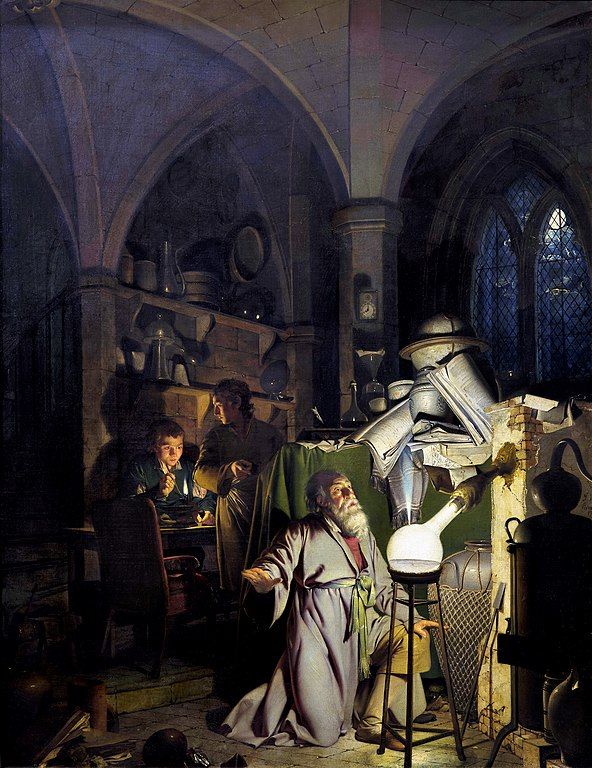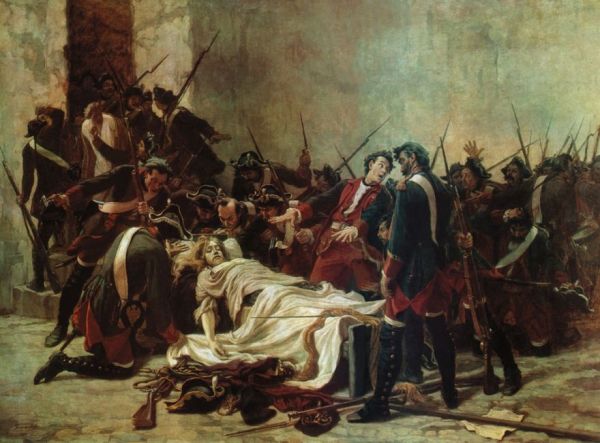We've all seen this illustration in movies and cartoons when a character has to make a moral decision- a small devil stands on one shoulder, and an angel on the other, whispering in the character's ear to persuade him to do the right thing or the wrong thing. The devil represents temptation, and the angel represents the conscience. It's pretty much the perfect way to illustrate a moral dilemma, but where did it come from? You won't be surprised to learn that the basic idea goes way back, at least a couple thousand years or so. But why are these figures small and standing on someone's shoulders? Duh, the easier to whisper in his ear, my dear. Everyone knows what it means, and it's certainly less boring than just using a disembodied voice to explain to the audience what the character is thinking. Which one will he listen to? Well, for that you will have to watch the movie. -via Laughing Squid
New York Comic Con 2024 was held over this past weekend, and there were many awesome costumes that looked like they just walked off a movie set, or a spaceship, to be honest. However, I've always been drawn to cosplayers who show some imagination and cleverness. John Farrier was taken with a woman dressed as a Pizza Hut. My pick among those unexpected costumes is this guy who attended the con as a Muppeteer. He had the puppets, but which Muppet master would he dress as -Jim Henson or Frank Oz? Splitting his body down the middle, he didn't have to decide, and was able to carry two Muppets. You have to wonder if he did the voices, too. I tried to find out who this cosplayer is, but I have not found his name yet. This picture is just one among an astonishing gallery of 43 magnificent NYCC cosplay pictures posted at Buzzfeed.
One way to get everyday people on board with a robot is to make it less like a human, and therefore less creepy. LimX Dynamics introduces the TRON 1, a bipedal robot that looks relatively unthreatening. It's only half the height of a human, and resembles robots we are familiar with from the movies (Tron, Star Wars, Robocop, Battlestar Galactica, etc.). All in all, it resembles an ostrich of sorts more than a human. For a two-legged robot, it balances really well, and has three different "foot" modes that can be switched out. And boy, can it dance!
You can have your own Tron I for just $15,000. I'm sure it can do things besides walk upstairs and dance, but what it's supposed to be useful for isn't really explained. I can't see it pushing a lawnmower or washing dishes. I'm sure it would be easy to attach a machine gun or a flamethrower to it. -via Boing Boing

What most people know about alchemy is that alchemists were looking for a magical way to convert lead or other common material into gold. They were also looking for a magical formula for immortality. This is a rather simplistic view of a discipline that changed and evolved over a thousand years' time.
In the beginning, alchemy was science, although rudimentary from our modern point of view. You could call it beginner's chemistry. Alchemists did experiments to learn the properties of materials and what could be done with them, although their theories were often derived from philosophy, religion, and a belief in what we would today call magic. Alchemists were mysterious, because those hoping to manufacture gold kept their activities private, and even with those who didn't, it was hard for anyone to understand what they were doing.
In the 16th century, there came to be a split between alchemy and pure science without the philosophy attached. Religion also moved on and considered alchemy to be heretical. But the alchemists made some pretty important discoveries while they were trying to manufacture gold. Read about alchemy and how it changed over time at Mental Floss.
(Image credit: Joseph Wright of Derby)

There are many great cosplays at the New York City Comic-Con, which is one of the largest fandom conventions in the world. X user Tanooki Joe shares photos of this woman who is festooned to resemble a Pizza Hut restaurant from the 1980s and 90s.
The iconic red booths are immediately recognizable to any 80s kid. The cosplayer offers other visitors to the convention what appear to be shakers of Parmesan cheese and crushed red pepper for a fake pizza.
-via Super Punch

Medical researchers in the UK recently dissected the body of a 78-year old man who had donated his remains for research. They were surprised at his genitalia: the man had three penises.
Diphallia, which is the state of having two penises, is rare. But, according to the researchers' article in The Journal of Medical Reports, there is only one other known case of triphallia in medical literature.
This gentleman had one primary and two secondary penises. The largest had a functional urethra which it shared with the medium-sized penis. The smallest of the three penises did not have a urethra at all. Each, however, had a corpora cavernosa and a glans penis.
-via Dave Barry | Screenshot from Inglourious Basterds

The 1990 film The Hunt for Red October is a thrilling film about a Soviet submarine captain who tries to defect to the United States with his advanced ballistic missile submarine. It's an adaptation of a Tom Clancy novel of the same name. It's an exciting, well-paced movie with highly effective visual effects, even by today's standards.
One of the most essential props in the film is a model of the Soviet boomer. X user Winston Smith (possibly not his real name) adores the movie and was able to purchase the model.
He mentions that he has yet to tell his wife about the purchase. I think he may need to make an emergency dive soon.

The Catholic Pipe Company is the firm of artist Caleb C. Mitchell. From his workshop in Hebron, Nebraska, Mitchell produces ornately designed and precisely rendered images of Catholic saints. For him, it's an act of veneration.
Above is Saint Sebastian, who was martyred under Emperor Diocletian during approximately the year 288.
In the movies, pirates are charming scalawags who operate outside of the normal limits of civilization. This might give you the wrong idea about the Golden Age of Piracy in the mid-17th century. Sure, some governments turned a blind eye to certain pirates, as long as they carried out activities that benefitted some nations in their competition over other countries. Most pirates were just fine with deadly violence, whether in war or in plundering coastal villages or even in competition with each other. They could be pretty brutal overall. Captains reinforced the pecking order and kept their crews in line with the threat of a painful death, and rivals were treated even worse. Short of death, permanent maiming was on the table, too, which explains the hooks and peg legs. Those eyepatches had their uses, but they might have hidden a missing eye as well. Some pirates weren't above a bit of torture, either, to get what they wanted. Weird History relates some stories of pirates that might tarnish their cinematic reputation.

In the early 1950s, author Kurt Vonnegut was trying to get his writing career off the ground. His first book received favorable reviews, but the money wasn't coming in. With a family to support, he tried all kinds of jobs and ventures to bring in income. One he was particularly dedicated to was the development of a board game. It was a straightforward military strategy game called General Headquarters, and drew on his experience in World War II. But he never found a publisher that was interested.
Fast forward to the 21st century, and game designer Geoff Engelstein heard about the lost game and contacted Vonnegut's estate about it. He obtained 40 pages of Vonnegut's notes, rules, revisions, and rejection letters. From those, Engelstein put the game together and now it's available, 70 years after its inception, at Barnes & Noble. Read about General Headquarters at Open Culture. -via Nag on the Lake

Being a Russian historical figure is never a picnic, but Emperor Ivan VI had it worse than many. He was born in August of 1740, the son of a duke and duchess. His mother was the niece of the reigning Empress Anna, who had no children. At the age of two months, he was declared the heir to the throne just before Anna died. A year later, the toddler Emperor Ivan VI was overthrown by his cousin Elizabeth Petrovna, and he and his parents were imprisoned. At age four, he was separated from this parents and put into solitary confinement and the public was led to believe he was dead. While his guards were kept in the dark as to their prisoner's true identity, Ivan was taught to read only so he could read the Bible, and was otherwise left alone. He grew to be mentally ill due to years of isolation, and weak from the lack of any medical attention during his confinement. However, Ivan knew who he was, and eventually some of the guards knew, too.
When Catherine the Great ascended to the throne in 1762, she issued secret orders that the "nameless one" was to be put to death if anyone ever tried to take him out of his prison. And that's exactly what happened in 1764, just before Ivan's 24th birthday. Read about the hapless emperor at Wikipedia with more commentary at reddit. -via Messy Nessy Chic
(Image credit: Ivan Ivanovich Tvorozhnikov)
During harvest season, we love to see videos of zoo animals having fun playing with and eating pumpkins. At the Oregon Zoo, they have the annual "Squishing of the Squash" event for the elephants (see several previous videos of that) Now we get to see the rhinos do it!
The Oregon Zoo's black rhinos showed us what those horns are good for -they are tools, used to open up a pumpkin by goring or even slicing it. They are also pretty good for tossing things or even carrying them around. You may call these magnificent beast rhinos, rhinoceros, tank puppies, or unicorns. Oh, yeah, the elephants have already had their Squishing of the Squash this year, too.
The pumpkins are donated by local farmers with extra pumpkins and hobbyists who grow giant pumpkins for the fun of it. The zoo animals have enjoyed a lot of prize winners in the past! A good time was had by all. -via Laughing Squid
On September 2-3, 1935, the first recorded category 5 hurricane swept through southern Florida. Storms were yet to be given names, so it became known as the Labor Day hurricane. Ernest Hemingway lived in Key West at the time, and the damage on that island was relatively minor, although it was cut off from the mainland when the hurricane wrecked the railroad bridge. Nearby Upper Matecumbe Key and Lower Matecumbe Key were flattened, with all buildings and most vegetation stripped away. Hemingway wrote about the destruction, particularly the 400 people who died in the keys.
Many of the dead were World War I veterans, employed by the federal government to work on highway construction. Hemingway was incensed that despite several days warning, these men were not evacuated to the mainland, but were left in their ramshackle dormitories. Their bodies were not taken away for days. The scene reminded Hemingway of the mass deaths he had seen on the battlefields of the Great War. Read how Ernest Hemingway reported the carnage and his anger at the Conversation.
The Soviets were really big on proving they were the best at everything, whether it was science, nuclear weapons, the space race, or Olympic competition. That probably had something to do with why they decided to dig the deepest manmade hole on earth. Oh, there were plenty of scientific research reasons, but the expense involved leads us to believe it was mainly another superlative they could brag about.
The Kola Superdeep Borehole is more than seven miles deep, or 12,262 meters, to be exact. The Soviets kept digging for 19 years, from 1970 to 1989. You may think, well, there's your answer for why they stopped digging, because the Soviet Union collapsed in 1991 after a couple of years of really tense internal struggles. But the project had other problems, too, that had to do with the earth and what's going on seven miles down there. Half as Interesting explains the project in a little over seven minutes; the rest of the video is an ad. -via Digg
It turns out that they sell edible Crocs in Japan
— 𝕏 Ali Al Samahi 𝕏 (@alsamahi) October 14, 2024
These are waffles with various fillings added inside. pic.twitter.com/pW83mh5U9g
Foodbeast is calling these confections "edible crocs," but I think that appellation is insufficient. Any croc is edible if you put forward sufficient effort. The essential difference is that people enjoy eating these pastries, which are shaped like the futuristic but stupid footwear and are about the size of a child's shoe.
You can find your own at a bakery in Ōkubo, which is a Korean immigrant neighborhood of Tokyo. There are red bean paste, chocolate, and cheese fillings available.
-via Massimo




